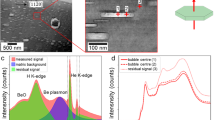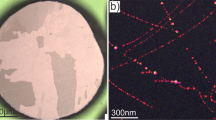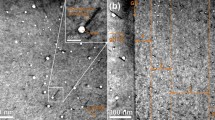Abstract
THE formation of surface blisters on metals bombarded with low energy inert gas ions was first observed by Primak1 but only recently, when the potential importance of blistering in the first wall of a fusion reactor became recognised, has much further attention been paid to the phenomenon2,3. Most of this work has used scanning electron microscopy to examine the blistered surface although considerable information has also been obtained from gas release measurements both during bombardment and in post-bombardment anneals. Transmission electron microscopy has been used to a lesser extent but nevertheless has yielded important information on the substructure within the layer where the gas atoms came to rest—normally some hundreds of Ångstroms from the metal surface. For example, several workers have shown that gas bubbles form in thin foils irradiated with low energy (<300 keV) helium or argon ions4–6. One interesting fact (D. J. Mazey, unpublished) is that over a wide temperature range from 600 °C down to 20 °C, 36 keV helium bombardment of molybdenum produces a fine distribution of helium bubbles crystallising on to a body-centred-cubic (b.c.c.) lattice analogous to the void lattice4,7. Here I describe an extension of transmission microscopy to view the blisters themselves and suggest some details of the blister formation mechanism.
This is a preview of subscription content, access via your institution
Access options
Subscribe to this journal
Receive 51 print issues and online access
$199.00 per year
only $3.90 per issue
Buy this article
- Purchase on Springer Link
- Instant access to full article PDF
Prices may be subject to local taxes which are calculated during checkout
Similar content being viewed by others
References
Primak, W., J. appl. Phys., 34, 3630 (1963).
Applications of Ion Beams to Metals (edit. by Picraux, S. T., EerNisse, E. P., and Vook, F. L.), (Plenum, New York, 1974).
Proc. Conf. on Surface Effects in Controlled Fusion Devices, J. nucl. Mat., 53 (1974).
Sass, S. L., and Eyre, B. L., Phil. Mag., 27, 1447 (1973).
Thomas, G. J., and Bauer, W., in Applications of Ion Beams to Metals (edit. by. Picraux, S. T., EerNisse, E. P., and Vook, F. L.), 533 (Plenum, New York, 1974).
Hertel, B., Diehl, J., Gotthardt, R. and Sultze, H., ibid, 507.
Evans, J. H., Nature, 229, 403 (1971).
Steeds, J. W., Tatlock, G. J., and Hampson, J., Nature, 241, 435 (1973).
McCracken, G. M., Rep. Progr. Phys., 38, 241 (1975).
Erents, S. K., and McCracken, G. M., Rad. Effects, 18, 191 (1973).
Martin, D. G., Culham Report, R-103 (UKAEA, 1970).
Author information
Authors and Affiliations
Rights and permissions
About this article
Cite this article
EVANS, J. Formation of blisters in molybdenum bombarded with helium. Nature 256, 299–300 (1975). https://doi.org/10.1038/256299a0
Received:
Accepted:
Issue Date:
DOI: https://doi.org/10.1038/256299a0
Comments
By submitting a comment you agree to abide by our Terms and Community Guidelines. If you find something abusive or that does not comply with our terms or guidelines please flag it as inappropriate.



